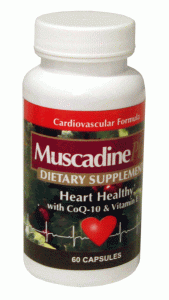Muscadine and Scuppernong are two types of grapes that are native to the southeastern United States. While both are similar in many ways, there are some key differences between the two.
 Flavor: Muscadine grapes are known for their sweet, juicy, and slightly tart flavor, while Scuppernong grapes have a sweeter and milder taste.
Flavor: Muscadine grapes are known for their sweet, juicy, and slightly tart flavor, while Scuppernong grapes have a sweeter and milder taste.- Appearance: Muscadine grapes have thick skin and large seeds, while Scuppernong grapes have thinner skin and smaller seeds.
- Origin: Scuppernong grapes are a variety of muscadine grapes that are native to North Carolina. They are named after the Scuppernong River in the state.
- Use: Both muscadine and Scuppernong grapes are commonly used for making wine, juice, and jams. However, muscadine grapes are also used in savory dishes, while Scuppernong grapes are mainly used in sweets and desserts.
These grapes are similar but not identical, despite their cutesy names. Muscadines, including scuppernongs, is a type of the native American grape Vitis rotundifolia, which is found in the southeastern and south-central parts of the United States. That is to say, while all scuppernongs are muscadines, not all muscadines are scuppernongs. Both varieties are larger and more oblate than the farmed grapes sold in grocery stores, and they have larger seeds and thicker skins. In the areas of the United States where they are naturally abundant, they make for a delicious and simple snack.
The typical size of a muscadine grape in the United States is about 1 1/2 inches. They are typically used in jams, jellies, wines, and any other dish that calls for grapes or grape juice and do not form tight bunches but rather clusters of four or more fruits. The early immigrants gave these grapes the same name as the delicious muscat grapes used to make wine in Europe; this name later evolved into muscadine.
What Is Muscadine?
The roots of muscadine vines are employed as grafting stock despite the fact that the vines themselves do not thrive in California vineyards. Muscadine is a popular choice among viticulturists because of its resilience and natural resistance to pests and diseases. Muscadines, in contrast to table grapes, which ripen all at once in a hanging bunch, ripen singly in loose clusters. The yields from muscadine grapevines are potentially eight times higher than those from other grape species. Muscadines can produce up to 60 pounds of fruit per vine, while bunch grapes only produce about 8.
What is Scuppernong?
Although muscadine cultivars come in a wide variety of colors, black (or purple) and bronze are the most common. The “Scuppernong” grape is a bronze variety that was the first muscadine cultivar. It got its name from its discovery site in North Carolina’s Scuppernong River. Roanoke Island is home to the original mother vine, which has been flourishing there for hundreds of years. A bronze muscadine grape is commonly referred to as a scuppernong due to its botanical primogeniture. According to accepted botanical nomenclature, the term “Scuppernong” should be reserved for identifying a specific cultivar, not a broad range of colors.
- Many different types of black and bronze grapes fall under the umbrella term “muscadine.” The muscadine grape from which the Scuppernong is derived.
- For this reason, it is commonly held that all Muscadines are also Scuppernongs, although not all Scuppernongs are Muscadines.
One is a cultivar of the other because of fundamental distinctions in their connection. - So, any Muscadine grape cannot be called a Scuppernong, but any Scuppernong grape can be called a Muscadine.
- Scuppernongs and Muscadines are both endemic to the United States and are classified as grapes.
- Scuppernongs are more of a greenish or copper color, while Muscadines are a deep purple. In other words, Muscadines are the red grape variety while Scuppernongs are the white grape variety.
- White wine is manufactured from Scuppernongs, while red wine is made from Muscadines.
- Muscadine grapes have a sweeter flavor on the inside, while Scuppernong grapes have a more tart flavor on the inside.
- When it comes to health and wellness, both of these grape types provide their own distinct set of advantages.
- Grapes of the dark or purple variety have a higher Resveratrol content than those of the green or bronze kind. When it comes to phytonutrients or plant compounds, the darker the skin of a grape, the higher the concentration. Resveratrol is an antioxidant that has been shown to be effective against cancer and cardiovascular disease. So, include some Muscadines in your daily diet for a jolt of Resveratrol.
